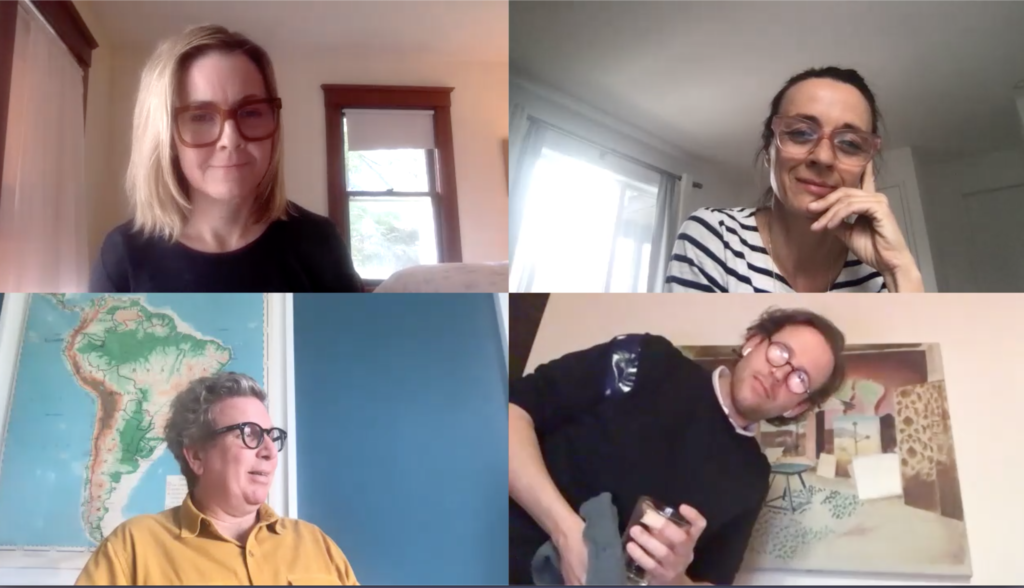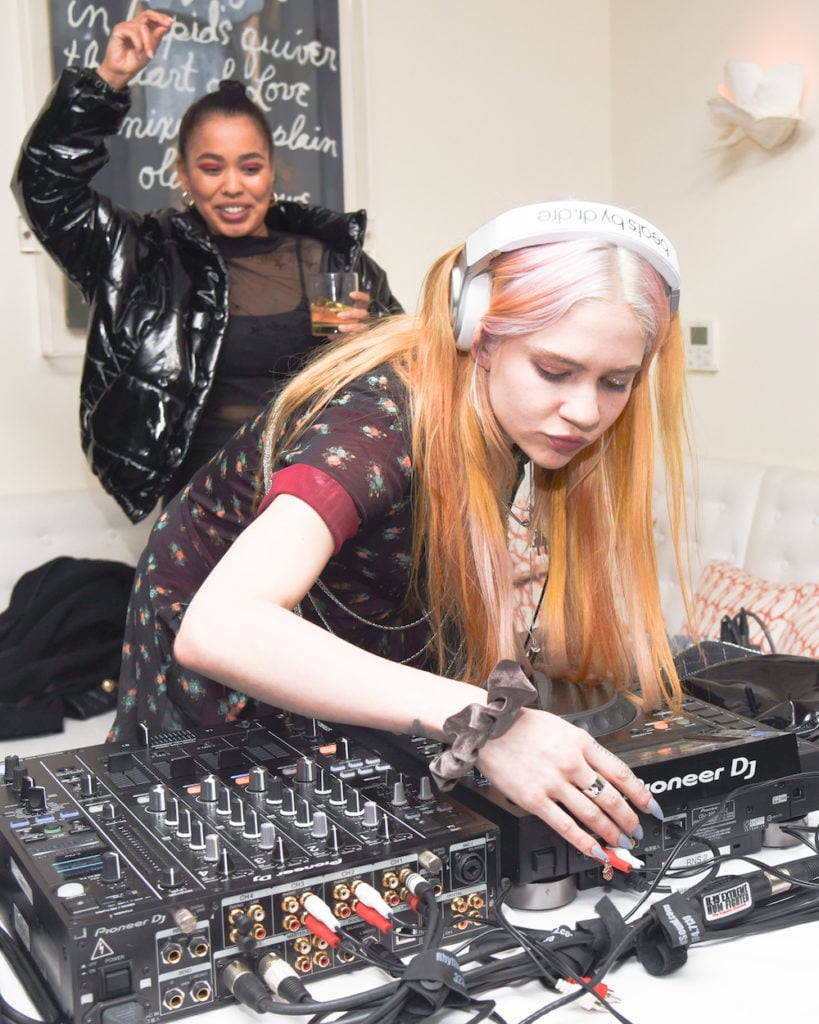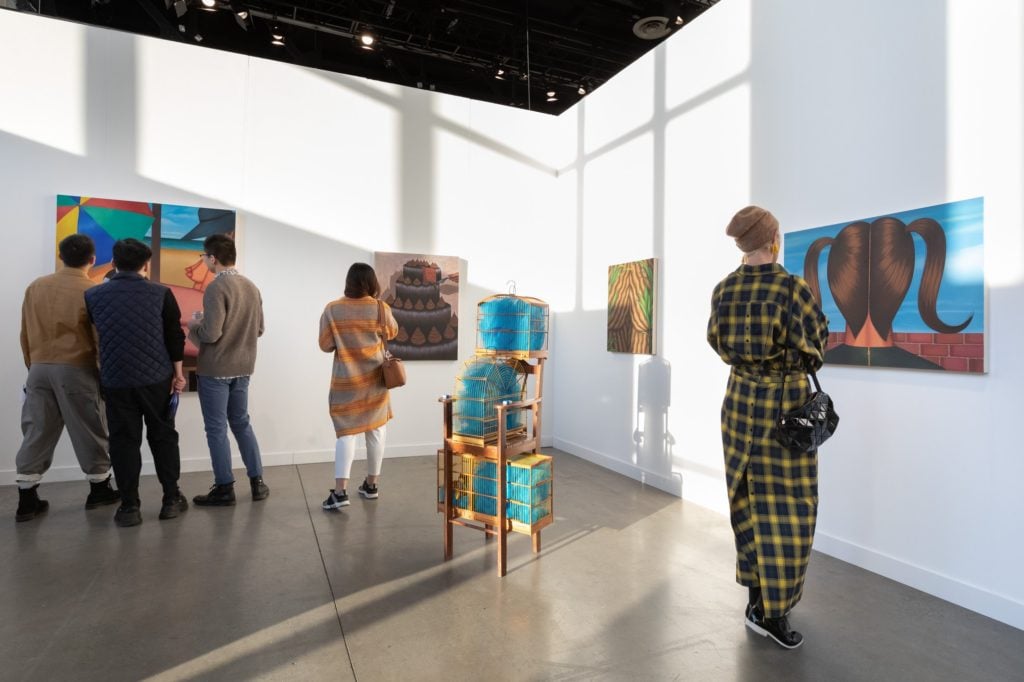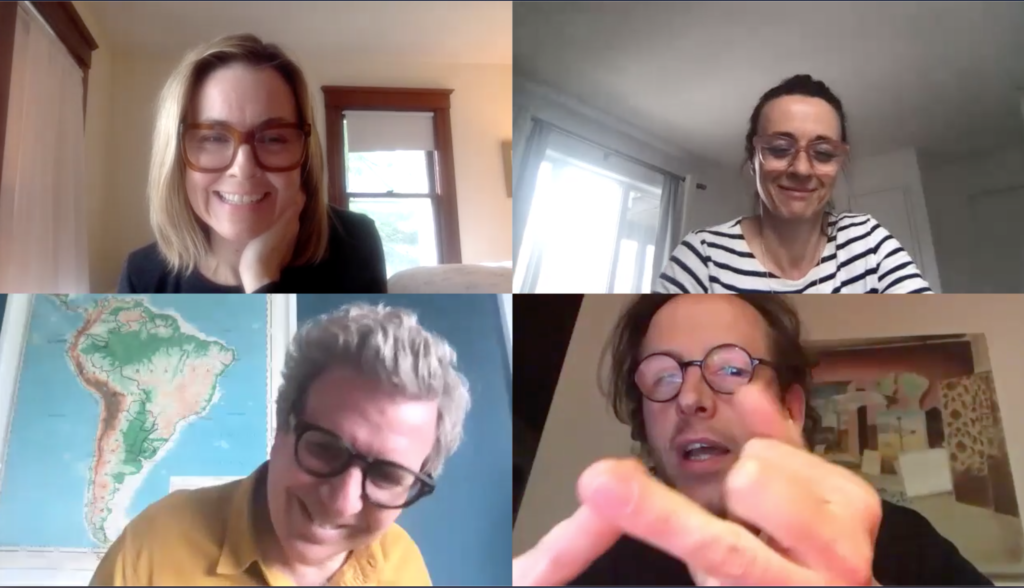This article was first published in German in the June issue of Art, das Kunstmagazin.
With the world still largely on lockdown, art dealers, like the rest of us, are working from home—and imagining what their industry will look like on the other side. On April 20, Claudia Bodin, the US editor of Art, das Kunstmagazin, convened a virtual roundtable among three forward-thinking art-market figures—König Galerie founder Johann Koenig (in Berlin), Independent Art Fair co-founder Elizabeth Dee, and Pace Gallery CEO Marc Glimcher (both in New York)—to discuss their vision for the art world after the lockdown era ends. At the time of the conversation, New York was in the thick of its shelter-in-place order, while Berlin was preparing to reopen. Koenig had just launched an online booking system for in-person gallery visits, which were quickly booking up, and Glimcher had recently recovered from his own battle with coronavirus.
Below, the three experts discuss why the art world as we know it is unsustainable—and what systems they hope will take its place.
How are you feeling these days after your experience with coronavirus, Marc?
Marc Glimcher: Good, I am totally back to normal.
Thank you for the honest article you wrote about catching the coronavirus, your recovery, and your thoughts about unsustainable practices in the art world, from the the travel, to the over-promotion of artists, to the ballooning overheads. Such honesty is usually not the first thing that comes to mind when one thinks about the art business.
Marc Glimcher: Unfortunately not.
Are we really going to see changes after we come out of this?
Marc Glimcher: I do not have unrealistic expectations, but let’s put it this way: If there was ever a good chance for change, it is probably now.
Johann, how are you doing in Berlin? You managed to stay in touch with the world with your “10AM Series” of live Instagram conversations with artists in their studios over Instagram Live.
Johann König: I think my wife wants me slowly out of the house, but I’m getting used to this and I start liking it.
Marc Glimcher: I have never been in one place for so long. I got back from a trip on the 3rd of March, got sick the day after, and have not moved much since. First of all, I have to confirm what Johann said: It feels great. It also makes you go through all kinds of thoughts like, am I not living my life correctly? Do I really need this? It certainly feels like some of the travel was inefficient. Like, what are art fairs again?

Booth of König Galerie at Code. Photo I DO ART Agency, Courtesy of the artists and König Galerie.
But 45 percent of business is done at fairs, according to the most recent Art Basel and UBS Global Art Market report.
Elizabeth Dee: I do not think all fairs are equal and I do not think all fairs are going to do well post-COVID. The big convention centers, hosting thousands of people, or locations without a native collecting community, places that you have to travel to, are going to suffer. But I think bespoke experiences where you have quality over quantity provide an opportunity for a more open, less densely crowded environment.
Johann Koenig: The main reason for fairs is to get things done quickly. We need them as a platform to reach our goals in a super-efficient way. From a collector’s perspective, at a good fair like Art Basel in Switzerland, someone who doesn’t know yet what he is doing and what inspires him gets an overview of the better end of the market, from postwar Modern art to the youngest contemporary art.
Isn’t it primarily a question of whether galleries must participate in 10 or more fairs a year?
Johann Koenig: Of course, we can question the necessity of Art Basel or any other fair. It is not just people buying art. There are committee meetings, board meetings. Why do we need to fly everything to Hong Kong and pay insane prices for a whole week in a hotel, even though we only want to stay for two nights? I did not do Art Basel Miami last year; I did not even apply for Hong Kong. I know what my gallery is worth. I know what I can do for my artists. I do not need the fair stamp. My advice to young art dealers is: Do what is right for you. You have to say no at some point.
Elizabeth Dee: It is that forthright honesty that is unique now. When I started, we always had to find a way to pay the country club bill even if we were not rich. If we wanted to compete, that was just the deal. We now see galleries who have been participating at Art Basel and other fairs for years and years and are leaving because what might be right for some might not benefit them long-term. There’s a comfort level with that we didn’t see before, and I think it’s healthy because fairs had too much power. Galleries should have ownership over the fairs that they participate in and be partners with the fairs. As a gallery, I would not do a fair if I could not call the head of PR and have a dialogue about what I’m bringing or if I could not call the director and ask him or her, what are you planning this year? I think expectations are changing.
Marc Glimcher: Economics is the ultimate ecological regulatory system. So as long as we can all afford to do them, obviously we are going to. From time to time I say: OK, this is it! And we did reduce from 23 fairs to 16 last year. But the interesting thing we’re going to see is that everybody came into this crisis burning everything they could. Very few people have some kind of cushion.
Elizabeth Dee: Especially in America.
Johann Koenig: The US is so extreme, people immediately got laid off. You cannot compare it to the amazing social net in Germany everybody falls into and is protected by. In the US, the world is over—and a couple of months later, it is the best world possible.

Martin Lawrence Gallery in Soho is boarded up during the coronavirus pandemic on April 17, 2020 in New York City. (Photo by Debra L Rothenberg/Getty Images)
A lot of the galleries cannot afford not to sell anything for two months.
Marc Glimcher: Many galleries are going to close. Everyone traded in—either they gave up a safety cushion or their honest, deeply held beliefs. Instead, they got on the treadmill, hit 10 incline and speed, and started running as fast as they could. But people do not love us because we could run so fast. I just did our dealers’ meeting online with about 30 people from all over the world who work for the gallery. They all said they wanted to go back to basics instead of expanding further. If everybody feels that fatigue, let’s do something about it. Let’s show a little courage. How are we going to do five art fairs in three months as it might be planned for fall now?
Elizabeth Dee: That is a problem.
Marc Glimcher: We all have shows piled up and what happens on September 1st? We just switch the whole thing on and every piece of art is for sale at the same time?
Elizabeth Dee: And what is the price of shipping going to be? Fairs need to collaborate. How is this sustainable from an ecological, economic standpoint? What about the fatigue, the market fatigue? You don’t turn on the stock market after it has been closed and have it run for seven days straight. We have to have an open conversation about this.
Marc Glimcher: If the galleries are desperate—and we have seen desperation ruling the day for so long—and we all go for it with these five fairs in the fall, we will all lose money. We already lost a lot of money, I don’t know if you have noticed? It is like having a heart attack and the first thing you do is eat a cheeseburger.
Elizabeth Dee: We’ve got to get real. I talked to collectors yesterday and they told me that they are not going to any of the European fairs this year. They will wait for New York fairs to reopen. Otherwise, they’ll go to the galleries.
Marc Glimcher: Art Basel Miami is going to be a hit, it is long enough away. [Florida] has a Republican governor who started opening bars and beaches already. The next coronavirus spike is not going to dominate any news cycle. We are going to have an election that is going to dominate the news. I bet people are going to Florida…
Elizabeth, you have been using this crisis to work on ideas about how to build a different, and maybe stronger, art market.
Elizabeth Dee: I think downturns expose a lot, especially the flaws and what is not working. Whatever you want to call this moment, it is one of these unique times when you are forced to assess whether the business models [you are using] are the right ones. Success and growth mean a lot of different things to a lot of different galleries.
Marc Glimcher: Look, the core issue—and this is the first time that this has happened in the art world—is that the invention or the discoveries of the artists are not center stage any longer. Instead, galleries and gallery strategies, the idea [hat] we are an asset class is moving center stage. The thing that gives art value is the art experience, as we all know. But as soon as that stops being the central topic, we become a derivative of ourselves, a stock option on art. That does not mean it has evaporated the core thing that we do. But we should not forget that we are in the magic business.
Elizabeth Dee: Yes, we are.
Marc Glimcher: If you want to be in the asset management business, then go there! If the work of a 40-year-old painter from this year is worth more than a Franz Kline painting, then this is only the asset management business. That very expensive painting by a young artist could be a magical thing, but we are draining the blood out of it. Look at how many people are joining in the game. It is a lot fewer than in 2015 or the years before that. If you keep getting such a bad result, the collectors will stop saying, I picked the wrong artist, and they will start saying, I picked the wrong hobby.

Clockwise from top left: Elizabeth Dee, Claudia Bodin, Johann Koenig, and Marc Glimcher in conversation. Screen shot courtesy of Claudia Bodin.
So far, the art market has always came back.
Marc Glimcher: It won’t come back if you drain the blood out of it. I’m sorry, but you can destroy societal systems if you continuously soak the meaning out of them. In the art world, we think that we are invulnerable. That is how they felt in the classical music world. For 500 years, classical music was a massively significant system and part of a huge industry. It disappeared overnight. Technology changed; there were 50 years of artists breaking the rules as all modern artists did it. There was jazz, rock, and popular music, the radio, records. Don’t be so cocky about the imperviousness of our art system. You cannot keep abusing our system and keep assuming that there won’t be any consequences.
Johann Koenig: What do you mean, the hyper-inflated prices?
Marc Glimcher: I mean, you take a really talented artist and feed him into the art-world machine. How many times do you have to see that story unfolding the same way? Our job as dealers is to protect the collector and the artist. We are on opposite sides of the transaction. This is very old fashioned. So, you need kind of old-fashioned rules for our system. But are we still protecting the artist and are we still protecting the client?
Elizabeth Dee: In that case, who is the abuser and who is the abused? Is the abuser the gallerist or a combination of the gallerist and the collector as a default? Our gallery system has been moving further and further away from these values. The question is how do we keep supporting revolutionary artists?
Marc Glimcher: The artists are guilty, too, by the way.
Johann Koenig: Success has different meanings for different artists and different galleries. For me, it is amplifying the artist’s careers and helping them realize projects, getting them shows, and being present in collections that contextualize work. It is about realizing dreams. But then the whole cycle with a growing market—all the superlatives, the spectacles—got out of control. The entertainment elements at some of the dinners were as expensive as the art-fair presentation. This whole competition got out of hand.
Nobody is willing to slow down, spend less, or do fewer art fairs?
Elizabeth Dee: I don’t think reputational capital is enough to qualify success; I don’t think a great dinner is enough anymore. All these things are in the process of being identified as no longer essential. There are fairs that offer real context for the program and the artists—and there are fairs that don’t. There are exhibitions that push the ball forward—and there are exhibitions that don’t. There are collections that make an impact on an artist’s development; others just don’t. I think it’s that pace, Johann, you were talking about that was getting out of hand. That food chain that was hyper-accelerated to a point where it was hard to identify the context and the quality versus the quantity.
Johann Koenig: Also, do not forget the natural competition between artists as we saw it between Matisse and Picasso. I keep hearing from my artists: Why does she cost so much? Why does he get the pavilion? It always has been a mélange between realizing dreams and competing over them.
Marc Glimcher: This will be an opportunity for the pendulum to swing back. It was maybe starting to swing back anyways. The ability of galleries to work together is starting to be a very attractive idea. The competitive level we have been operating on is so self-destructive. I would compare it to the potluck ceremony in a village when the wealthiest man would bring all of his belongings to the town square and burn them all just to prove that he is the richest man in town. At some point, that ceremony becomes somehow unattractive. How many artists are you going to add to your program? Where are you heading with that, what is the plan? We represent a crazy number of artists—93—already. Is the plan to represent 500 at some point?

Grimes performing at a party hosted by Pace and Kayne Griffin Corcoran for James Turrell’s Roden Crater artwork. ©BFA
Photos: Linnea Stephan and Eunji Kim/BFA.com
Let’s talk about collaboration. Pace, in contrast to other big galleries, has been open to different models of co-representations of artists.
Marc Glimcher: You have to go back to defining what your goal is. I still consider Pace a New York gallery, an American gallery. Even though we have galleries in lots of countries. It is important to honestly want to co-represent artists and not just tolerate it and eliminate it as you grow. When we remove the local nature of the art world, it is going to lose all of its magic.
Johann Koenig: I always recommend my artists show with a North American gallery in America. I think a gallery lives from the personality of the art dealer—and it can be many personalities or directors. But in German-speaking countries, I can achieve for my artists what I bet nobody else without these roots can. It is such a personal business, in a positive and negative way. We, for example, need partners like Pace, knowing the New York and the US structures and how the system works. It really always has to be the best of all worlds, ideally the triangle of a mega-gallery, plus an innovative gallery, plus maybe the young gallery. But, of course, there might be conflicts with the mega-gallery signing these artists and their team just wanting to make them happy.
Elizabeth Dee: You have to be willing to walk away sometimes.
Johann Koenig: Let’s take the example of the artist Jordan Wolfson. I ultimately lost him over criticizing him. But this is my role, to be a sparring partner. We had this big dispute because he asked me to write on the website of my gallery that he is the most important artist of his generation. I refused as I did not think of it as a good idea. He left and joined David Zwirner.
Marc Glimcher: The tyranny of the artist. We are their loyal subjects for sure. But we have constructed a system where every artist that joins the gallery is a bullet in that art dealer’s gun and everyone that leaves is one bullet taken out. But artists move around now, that is just the way it is. One thing that helps is to calm down about it. If an artist leaves, it’s not the end of the world.
But for some smaller galleries, it is the end of the world, because this artist might be their main source of income.
Marc Glimcher: There still should be room for the word no. I am embarrassed about some of the artists I considered competing over, one in particular…
Johann Koenig: Who was the artist?
Marc Glimcher: I did not even tell my father or my wife about this. The galleries should bleed for the artists; my father was very much part of forming this ethos. But you have to believe in yourself enough to sometimes be able to say no—not just to the artist, but to an extra art fair or opening another gallery or doing this or that. Now that you are just paddling as fast as you can, this is maybe a moment to paddle a little slower and to try to get back to the thing you love. Because the reason you were successful in the first place was that people could recognize the depth of authenticity that you brought. The art world is shrinking around us because we are all after the same thing. Pretty soon, all we are going to be after is, how are we possibly going to pay the insane bills?

Installation view of the Independent Art Fair. Photo courtesy of Independent Art Fair NYC.
It sounds like you see a spirit of change, Elizabeth?
Elizabeth Dee: Before this, there was this assumption that bigger galleries are better off, and everybody else is a victim of the system. So the idea of survival was joining up with peers who identified with what you identify with, whether it was your city or your generation. I never really bought that the bigger galleries were winning the war and were free from the same challenges. I think it is much more complex than that. The second people get honest about their own unique circumstances, interesting things are going to happen for each gallery associating differently across these cities, generations, and footprints. I’m not saying that every gallery is feeling like they want to share every aspect of their issues, but I definitely think that the more this conversation grows within the community, the more change is actually potentially possible. I think we will see an art world in the future that is more intergenerational and… breaks through perceived class differences. The potential for Marc, who represents one of the top mega-galleries, and a gallery that is just starting is actually more possible in this future scenario. I would like to support that. To start, we can actually have dealer-to-dealer, gallery-to-gallery conversations.
Johann Koenig: How was it when you started?
Elizabeth Dee: I think there was a sense of, you have to fake it till you make it and you have to defend your territory ruthlessly. There was definitely a generational bond, but it was not like that you had mentors giving you advice. People are coming together more now, which is much healthier.
Johann Koenig: In Berlin, we have five different initiatives, among them Gallery Weekend and Office Impart, for a really not so important art market, at least internationally. How come they all think they can do it themselves? I tried to bring them together, but it seemed to me that there’s no interest. I think there’s so much we can learn from each other. We are always exchanging ideas. For our new booking system for gallery visits, for example, I got advice from the gallery Various Small Fires in Los Angeles.
Elizabeth, you have been working on an idea for a new initiative to get collectors on board and help out galleries and museums at the same time.
Elizabeth Dee: The pipeline is fragmented between the for-profit community, the galleries, and the nonprofit community, the museums. What I’m trying to do is engage an idea around the collector’s resources for something that functions at both ends. The concept is that collectors would give money as a non-profit donation to crowd-fund acquisitions for museums and fast-track those acquisitions for artists. The main focus for museums in the US for the next two to three years will be getting their operational budget sustained and making sure that patrons support the mission to recover and keep operating capital. To keep their doors open will be the main concern. Collectors may not want to buy a $100,000 painting by an artist they are just getting to know because it just does not feel like an environment for discovery right now, but I think they would easily commit $5,000 or $10,000 toward that work, especially if it is going directly to the institution. And that would also help support the galleries.
Are collectors at all interested in buying at the moment?
Johann Koenig: I must say we’re doing surprisingly well. We were planning a show with Loie Hollowell for Gallery Weekend and we have sold out her show already. The same goes for Sarah Morris; we have an exhibition locked down in New York City which was meant to go to Tokyo. What had a strong market before COVID still has a strong market now, and eventually [it] will even be stronger. Because it is really about the asset class quality of the art. We are not in this because we are asset managers, like Marc said earlier, but I could also not ask my clients to spend €250,000 and not talk about the potential loss and growth.
How are artists responding to this crisis and issues like social inequality that have come even further to the surface as a result?
Johann Koenig: With too many possibilities things are not necessarily better. I see some artists starting to work on a smaller scale and being very innovative.
Marc Glimcher: We still have an open question about the democratization of art. It will be a boom for the artists who will continue to make paintings and sculptures for exactly the reasons Johann said. Tough times always make for great art. But those artists who are continuing to explore the questions of how do I have a practice and decommodify it at the same time, this is more fuel for that.











